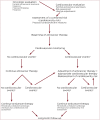Joining Forces: Establishing a Cardio-oncology Clinic
- PMID: 30588356
- PMCID: PMC6303000
Joining Forces: Establishing a Cardio-oncology Clinic
Abstract
Patients have been surviving cancer diagnoses at a steadily increasing rate over the past few decades. Despite the encouraging decline in cancer morbidity, the cardiovascular effect of some chemotherapy medications is concerning. Moreover, even though there is extensive knowledge of the pathophysiology and increased risk of cardiotoxicity, there is a lack of specific guidelines and adequate cardio-oncology programs focused on reducing cardiovascular risks or disease in patients undergoing cancer treatment. The high incidence of both cardiovascular disease (CVD) and cancer warrants the collaboration of oncology and cardiology providers to screen and promptly treat CVD, and thereby provide an opportunity to improve cancer patients' quality of life both during treatment and extended through cancer survivorship. We found no designated cardio-oncology programs in our geographic area from Poughkeepsie to New York City; therefore, a feasibility project was developed in collaboration with a cardiologist and a cardiology nurse practitioner specializing in oncology at our institution. The project included the development and implementation of a cardio-oncology program in a suburban community cardiology practice in order to provide service in this area to breast cancer patients at risk for cardiotoxicity. The Reach, Effectiveness, Adoption, Implementation, and Maintenance (RE-AIM) framework was employed to guide the project and enhance the translation of research into practice through planning and execution.
Figures




Similar articles
-
A comprehensive pediatric cardio-oncology program: a single institution approach to cardiovascular care for pediatric patients with cancer and childhood cancer survivors.Cardiooncology. 2024 Apr 6;10(1):20. doi: 10.1186/s40959-024-00211-7. Cardiooncology. 2024. PMID: 38582914 Free PMC article. Review.
-
The Cardio-oncology Program: A Multidisciplinary Approach to the Care of Cancer Patients With Cardiovascular Disease.Can J Cardiol. 2016 Jul;32(7):847-51. doi: 10.1016/j.cjca.2016.04.014. Epub 2016 May 6. Can J Cardiol. 2016. PMID: 27343743
-
Cardiovascular drug interventions in the cardio-oncology clinic by a cardiology pharmacist: ICOP-Pharm study.Front Cardiovasc Med. 2022 Sep 29;9:972455. doi: 10.3389/fcvm.2022.972455. eCollection 2022. Front Cardiovasc Med. 2022. PMID: 36247485 Free PMC article.
-
Using the consolidated framework for implementation research (CFIR) to guide implementation of cardio-oncology services.Learn Health Syst. 2023 Dec 13;8(2):e10402. doi: 10.1002/lrh2.10402. eCollection 2024 Apr. Learn Health Syst. 2023. PMID: 38633023 Free PMC article.
-
Modern concepts in cardio-oncology.J Thorac Dis. 2018 Dec;10(Suppl 35):S4386-S4390. doi: 10.21037/jtd.2018.11.110. J Thorac Dis. 2018. PMID: 30701105 Free PMC article. Review.
Cited by
-
The Role of Nursing in the Delivery of Cardio-Oncology.Curr Treat Options Oncol. 2024 Oct;25(10):1268-1275. doi: 10.1007/s11864-024-01241-0. Epub 2024 Sep 17. Curr Treat Options Oncol. 2024. PMID: 39287714
-
A comprehensive pediatric cardio-oncology program: a single institution approach to cardiovascular care for pediatric patients with cancer and childhood cancer survivors.Cardiooncology. 2024 Apr 6;10(1):20. doi: 10.1186/s40959-024-00211-7. Cardiooncology. 2024. PMID: 38582914 Free PMC article. Review.
-
Personalizing Heart Failure Care to the Patient With Cancer.Curr Heart Fail Rep. 2022 Feb;19(1):1-6. doi: 10.1007/s11897-021-00536-9. Epub 2022 Jan 9. Curr Heart Fail Rep. 2022. PMID: 35000125 Review.
References
-
- American Cancer Society. Cancer Facts & Figures 2015. 2015 Retrieved from https://www.cancer.org/content/dam/cancer-org/research/cancer-facts-and-....
-
- Cardinale Daniela, Bacchiani Giulia, Beggiato Marta, Colombo Alessandro, Cipolla Carlo M. Strategies to prevent and treat cardiovascular risk in cancer patients. Seminars in oncology. 2013;40:186–198. - PubMed
-
- Cardinale Daniela, Colombo Alessandro, Lamantia Giuseppina, Colombo Nicola, Civelli Maurizio, De Giacomi Gaia, Rubino Mara, Veglia Fabrizio, Fiorentini Cesare, Cipolla Carlo M. Anthracycline-induced cardiomyopathy: clinical relevance and response to pharmacologic therapy. Journal of the American College of Cardiology. 2010;55:213–220. - PubMed
-
- Cardoso F, Costa A, Norton L, Senkus E, Aapro M, André F, Barrios C H, Bergh J, Biganzoli L, Blackwell K L, Cardoso M J, Cufer T, El Saghir N, Fallowfield L, Fenech D, Francis P, Gelmon K, Giordano S H, Gligorov J, Goldhirsch A, Harbeck N, Houssami N, Hudis C, Kaufman B, Krop I, Kyriakides S, Lin U N, Mayer M, Merjaver S D, Nordström E B, Pagani O, Partridge A, Penault-Llorca F, Piccart M J, Rugo H, Sledge G, Thomssen C, Van’t Veer L, Vorobiof D, Vrieling C, West N, Xu B, Winer E. ESO-ESMO 2nd international consensus guidelines for advanced breast cancer (ABC2)†. Annals of oncology : official journal of the European Society for Medical Oncology. 2014;25:1871–1888. - PMC - PubMed
Publication types
LinkOut - more resources
Full Text Sources
Miscellaneous
